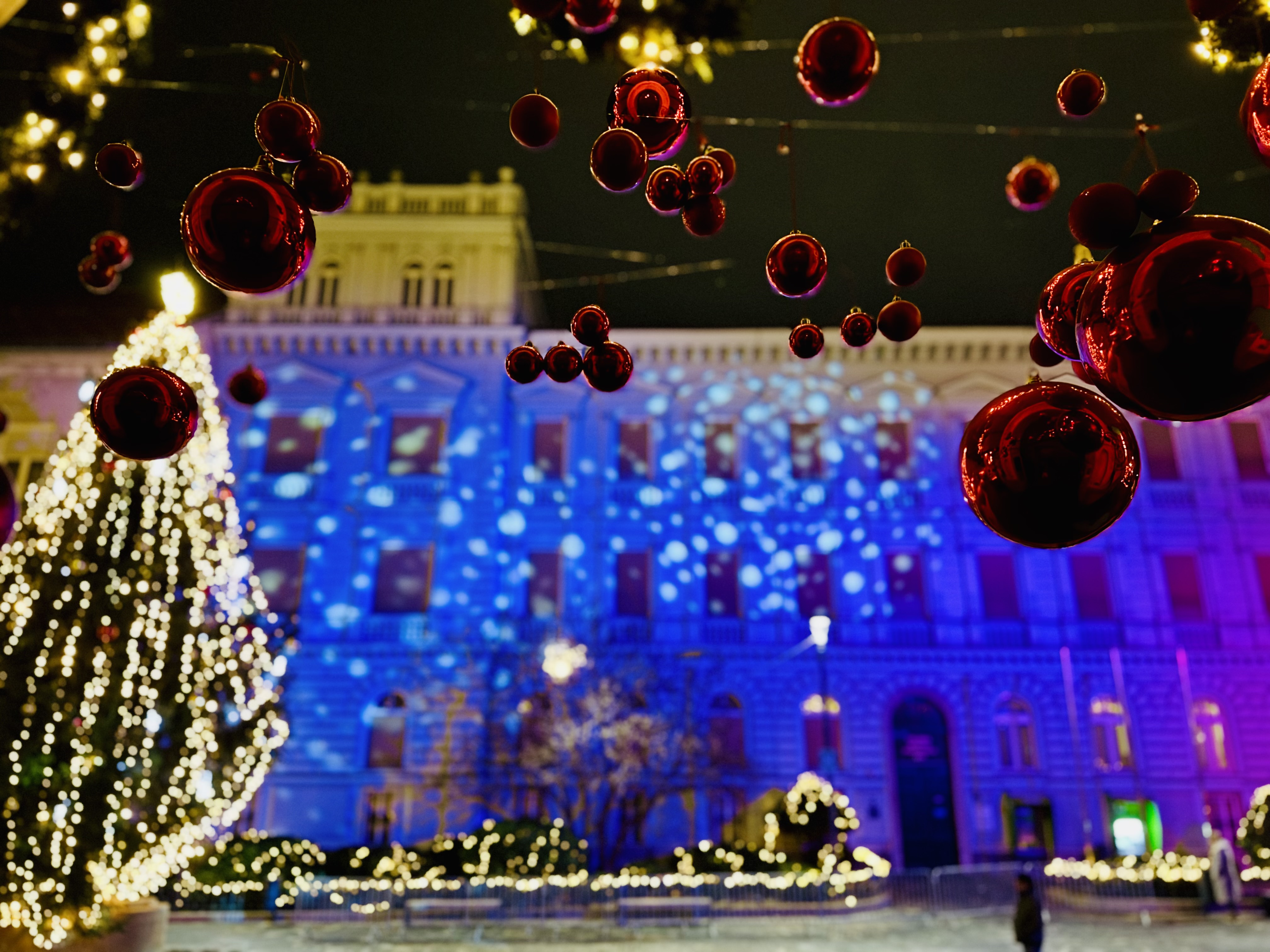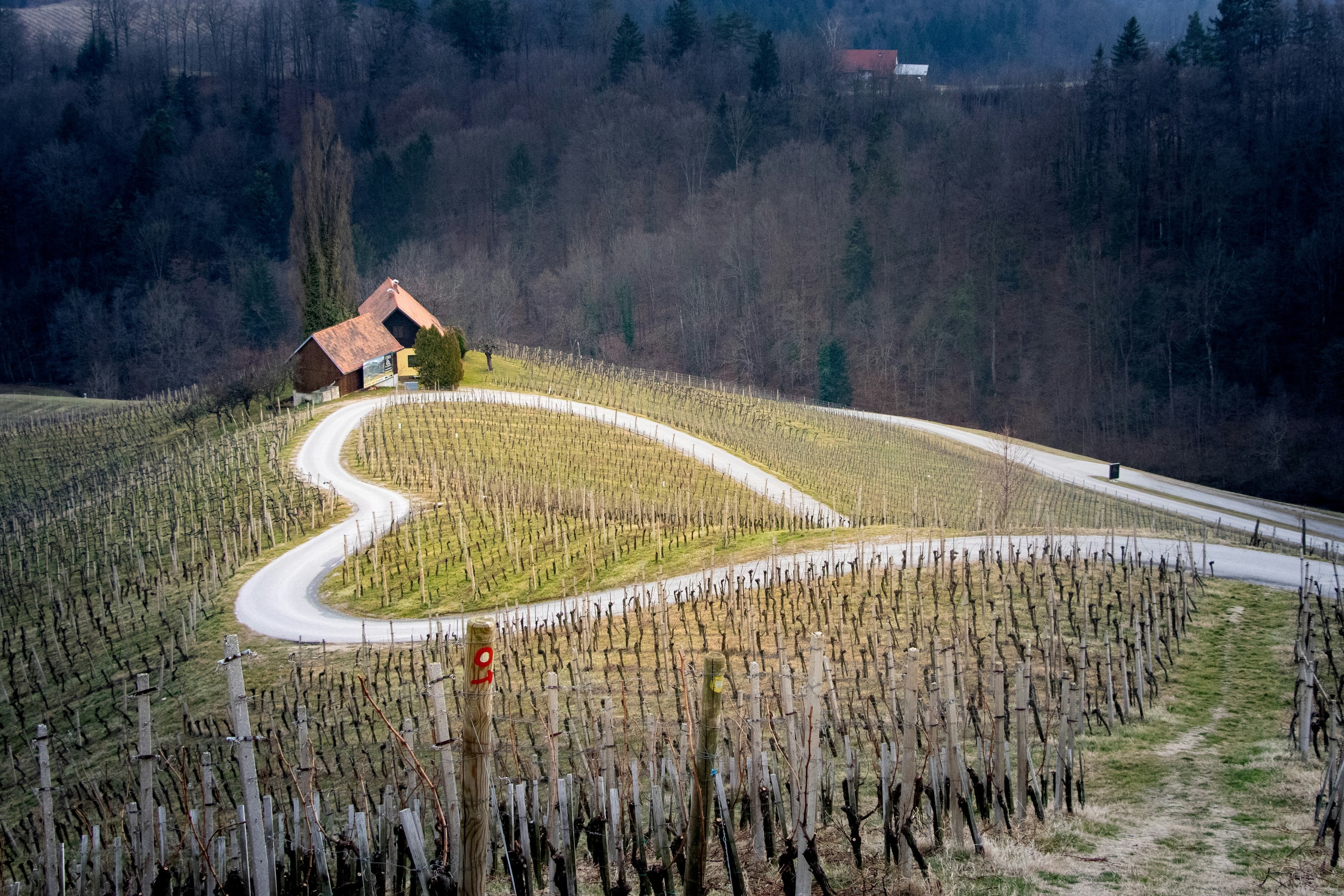Mediterranean Slovenia

A bit of Tuscany, a bit of Southern France, yet still authentically Slovenian. The western part of Slovenia is not defined by mountains and green meadows but by vineyards, karst landscapes, and coastline. This is a region for those who enjoy the good life—fine food, drink, and a pleasant climate. Mediterranean Slovenia is quieter and more affordable than similar areas in Italy and France.
Mediterranean Slovenia is more than just its coastline. Explore the wine hills of Goriška Brda, often compared to Tuscany, the Vipava Valley, enclosed by the Kras Plateau and the Dinaric Alps, and the unique karst nature of the Kras region. Like the rest of Slovenia, Mediterranean Slovenia offers a variety of landscapes.
It is an ideal area to visit in the shoulder seasons (spring and autumn), as summers here can get too hot to be fully active.
Destinations in this area
Goriška Brda & Vipava Valley
When you visit Brda or the Vipava Valley, you feel like you're in Italy. The cuisine, architecture, nature, and culture are unmistakably Mediterranean. Throughout history, this region has been under Italian control at various points, leaving its mark. But still, this is undeniably Slovenia. In these areas, you won’t find big cities. The villages are small and old, with traces that go back centuries. Life here is peaceful and simple, with old traditions often still kept alive.
Brda and the Vipava Valley are authentic regions where high-quality wine is produced by passionate winemakers whose methods have evolved over many generations.
Brda is a small wine region bordered by Italy to the north, west, and south. It’s often called the Tuscany of Slovenia—thanks to the hills, old villages, and castles. But to do so would be unfair to this unique area.
Located between the high mountains of the Dinaric Alps in the east and the vast Karst Plateau in the west, the narrow Vipava Valley is literally a hidden treasure. When you descend into the valley, you’re transported from an Alpine environment into a Mediterranean one. It feels as though you’ve covered a thousand kilometers in less than ten.
Things to see and do
- Brda
Brda is a small but stunning wine region in western Slovenia, with rolling hills, charming villages, and vineyards. Located near the border with Italy, Brda is famous for its wine production, with a long tradition of winemaking that spans centuries. The region’s unique microclimate, shaped by the proximity of the Alps and the Mediterranean, creates ideal conditions for growing a variety of grapes, including Sauvignon Blanc, Merlot, and Refosco.
The landscape is dotted with picturesque villages, old stone houses, and ancient castles, giving Brda a rustic yet refined charm. Some of the most well-known towns in the region include Dobrovo, the largest village, and Šmartno, a medieval hilltop settlement that is a true gem with its narrow streets and traditional stone architecture.
Apart from wine tasting, Brda offers visitors the chance to explore scenic hiking and cycling routes, often leading through the vineyards and offering breathtaking views of the surrounding landscape. The Kozana River and the nearby Vipava Valley further enhance the beauty of the region.
Brda is an ideal destination for those seeking tranquility, authentic Slovenian culture, and high-quality wines in a breathtaking natural setting.

- Vipava Valley
The Vipava Valley is a beautiful and fertile region in western Slovenia, known for its rich agricultural lands, picturesque landscapes, and vineyards. Nestled between the Dinaric Alps and the Karst Plateau, the valley is a unique blend of Mediterranean and Alpine influences, offering an exceptional environment for both growing wine and enjoying outdoor activities.
The valley is famous for its wine production, with the climate and terrain providing perfect conditions for the cultivation of local grape varieties such as Pinot Gris, Sauvignon Blanc, and the indigenous Zelen. The region’s wine makers are known for their passion and expertise, producing wines that reflect the character of the land. Many wineries in the area offer tours and tastings, allowing visitors to explore the flavors of the region.
Aside from wine, the Vipava Valley is a great spot for nature lovers and outdoor enthusiasts. The valley is dotted with charming villages such as Vipava, Ajševica, and Goče, each with its own unique character and history. Hiking, cycling, and even paragliding are popular activities here, with stunning views of the valley, mountains, and surrounding countryside.
The valley’s mild climate makes it an ideal destination to visit year-round, but especially in the spring and autumn when the natural beauty is at its peak. It’s also a place where tradition and modernity blend seamlessly, with ancient architecture, historical sites, and a vibrant local culture.
- Nova Gorica
Nova Gorica is a vibrant city located in western Slovenia, near the border with Italy. It is often referred to as the "Gateway to Slovenia" due to its proximity to Gorizia, its twin city on the Italian side, which creates a unique blend of two cultures. Nova Gorica is a city of contrast, combining modernity with rich historical and natural attractions.
The city is known for its modernist architecture, tree-lined streets, and wide boulevards. One of the city’s main attractions is the Solkan Bridge, a stunning stone bridge built in the 20th century, which spans the Soča River and is one of the longest stone bridges in the world. The Soča River itself is a major draw for outdoor enthusiasts, offering opportunities for rafting, kayaking, and fishing.
Nova Gorica also offers a vibrant cultural scene, with theaters, galleries, and music festivals throughout the year. One of the key landmarks in the city is the Šempeter Archaeological Park, which features the remains of an ancient Roman settlement. Nearby, the Ajševica Hill provides panoramic views of the surrounding vineyards and hills.
For wine lovers, the region surrounding Nova Gorica is renowned for its vineyards and wine-making traditions, with numerous wine cellars offering tastings of local wines, especially those from the Brda wine region.
Nova Gorica is a great base for exploring the Soča Valley and its natural beauty, including the famous Triglav National Park and Kobarid. The city’s proximity to both Slovenia and Italy makes it an ideal spot for those looking to experience the best of both cultures.
HIGHLIGHT: European Capital of Culture 2025
How to get here?
Goriška Brda is located in the far west of Slovenia. From the north, you can reach the region via the Soča Valley, and it is also easily accessible from Italy. From Ljubljana, you first drive to the Vipava Valley, then cross the Soča River and Mount Sabotin to reach Brda.
The region is poorly or not at all accessible by public transport. The Vipava Valley is easily reachable by highway from Ljubljana, and the region borders Italy to the west. There is a train passing through the valley, but it does not run frequently.
Kras
Once, the Kras region was covered by a vast forest, hiding unique karst phenomena both above and below ground. Caves, sinkholes, and ravines still shape the landscape of the Kras today. However, much of the dense forests have disappeared. Large-scale deforestation took place in the past, with wood being used for the foundations of Venice. As a result, the landscape of this Mediterranean plateau, located close to the coast, appears somewhat barren, although forests have regrown in some areas.
In the Kras, you can enjoy hiking, admire the karst phenomena, and go cycling. Be sure to sample the local Teran wineand dried ham.
The Kras is easily accessible by highway. Drive towards the coast and follow signs for Sežana. You can also reach the region by train, with the largest station being Divača.
Things to see and do
- Lipica
Lipica is a historic town in southwestern Slovenia, famous for being the birthplace of the world-renowned Lipizzaner horses. Located near the border with Italy, Lipica is home to the Lipica Stud Farm, which has been breeding the majestic white horses for over 400 years. The farm is a must-visit destination for horse lovers and history enthusiasts.
In addition to the stud farm, Lipica is known for its beautiful, serene landscape, with rolling hills, lush meadows, and traditional Karst architecture. The area is perfect for hiking and cycling, offering visitors the chance to explore the natural beauty of the region while learning about its equestrian traditions.
The Lipizzaner horses are famous for their graceful movements and unique training, particularly in dressage. Visitors to the Lipica Stud Farm can enjoy guided tours of the farm, watch horse training sessions, and even attend performances by the Lipizzaner horses.
Besides its equestrian heritage, Lipica is also known for its golf course, making it an ideal destination for a relaxing getaway surrounded by nature and history. The combination of cultural heritage, natural beauty, and the legacy of the Lipizzaner horses makes Lipica a unique and memorable place to visit.
- Škocjan Caves
The Škocjan Caves are one of Slovenia's most remarkable natural wonders and a UNESCO World Heritage Site. Located in the Karst region, near the town of Divaca, these caves are famous for their breathtaking underground landscapes, vast chambers, and unique geological formations.
The caves are known for their impressive underground river, which has carved out a series of striking passages, galleries, and tunnels over thousands of years. Visitors can explore the cave system through guided tours, which take you through some of the largest and most awe-inspiring chambers. One of the most famous features of the caves is the Martel Chamber, one of the largest underground chambers in Europe, as well as the spectacular Škocjan Canyon, where the river flows through a deep ravine.
In addition to the cave's geological features, Škocjan Caves are home to a wide variety of cave-dwelling species and rich biodiversity, making it an important site for both nature lovers and scientists.
Outside the caves, the surrounding area offers scenic walking trails, and visitors can explore the Karst landscape, known for its unique rock formations, underground rivers, and traditional stone villages.
A visit to the Škocjan Caves offers a truly unforgettable experience, allowing you to witness one of Europe’s most impressive natural wonders.
- Štanjel
Štanjel is a charming medieval village located in the Karst region of Slovenia, known for its picturesque streets, traditional stone architecture, and stunning views of the surrounding landscape. Perched on a hill, Štanjel offers a glimpse into Slovenia’s past, with its narrow, winding lanes, ancient buildings, and well-preserved town walls.
One of the most notable features of Štanjel is the Karst architecture, with whitewashed stone houses and beautiful cobbled streets. The village’s main attraction is the Štanjel Castle, a fortified structure dating back to the 16th century, which offers a fascinating insight into the region's history. The castle's gardens, designed in an Italian style, are also a highlight, offering visitors a peaceful place to stroll while enjoying panoramic views of the Karst Plateau.
In addition to the castle, Štanjel is home to the Ferrari Garden, an impressive terraced garden built into the hillside. This garden, designed by architect Max Fabiani, is a great place to relax and enjoy the natural beauty of the area.
Štanjel is also known for its unique cultural heritage and is a perfect spot for walking, hiking, and cycling in the surrounding Karst region. Its tranquil atmosphere, rich history, and natural beauty make Štanjel an unforgettable destination for visitors seeking a blend of culture, history, and nature.
How to get here?
The Kras is easily accessible by highway. Drive towards the coast and follow signs for Sežana. You can also reach the region by train, with the largest station being Divača.
Slovenian Coast
Forty kilometers. That's how long the Slovenian coast is—short in distance, or rather, short in length. And a significant part of it is harbor. The Slovenian coast may not be large, but in terms of beauty? Absolutely. The ancient town of Piran, with its old houses, narrow streets, and the grand Tartini Square, rises like a pearl from the sea. It's a little micro-Venice. The town, the most densely populated area in Slovenia, was shaped during the time when the Slovenian coast was part of the Venetian Republic.
From the port city of Koper to the unique monumental salt fields of Sečovlje, the Slovenian coast, the northern part of the Istrian Peninsula, is a series of delightful beaches and charming towns.
Don’t forget the hinterland either. Right behind the coast, the wine hills rise. There are walking trails and wine roads through the area, offering absolute peace and quiet—even in high season.
The coast is easily accessible by both car and train. By train, you can reach Koper Station. By car, follow the highway to Koper.
Things to see and do
- Piran
Piran is one of the most beautiful and picturesque coastal towns in Slovenia, located on the Adriatic Sea. Known for its well-preserved medieval architecture, narrow winding streets, and charming atmosphere, Piran is often compared to Venice, though it remains a quieter, less crowded destination.
The town is dominated by its Piran Peninsula, which juts out into the sea, providing stunning views of the coastline. The Tartini Square, named after the famous composer Giuseppe Tartini, is the heart of the town, surrounded by historical buildings, cafes, and shops.
Piran is also home to the St. George's Church, perched high on a hill with a bell tower offering panoramic views of the town and the sea. The town’s Venetian-style architecture, including its city walls, adds to its charm.
Visitors to Piran can enjoy relaxing along its seafront, swimming in the crystal-clear waters, or taking a walk along the old city walls. The town is perfect for a romantic getaway, a relaxing beach vacation, or simply immersing oneself in the unique atmosphere of Slovenia’s Mediterranean coast.

- Koper
Koper is the largest coastal city in Slovenia, located on the Istrian Peninsula, and serves as the country's main port. The city has a rich history, with influences from the Venetian Republic, Austro-Hungarian Empire, and Italy, which is reflected in its architecture and cultural heritage.
The old town of Koper is a charming blend of medieval, Renaissance, and Venetian-style buildings. The Tartini Square, the heart of the city, is surrounded by beautiful historic structures, including the Praetorian Palace, the Koper Cathedral, and the Loggia, an open-air Venetian-style town hall. The Cathedral of the Assumption of Mary, with its impressive bell tower, offers panoramic views of the town and the coast.
Koper's harbor is a busy commercial port, but the city has also embraced tourism with its lively streets, cafes, and restaurants. The city's marina is perfect for strolling and enjoying views of the Adriatic Sea. The region’s Mediterranean climate and relaxed atmosphere make Koper an ideal destination for travelers seeking a mix of culture, history, and coastal beauty.
- Izola
Izola is a picturesque town located on Slovenia's Adriatic coast, just south of Koper. Known for its charming old town, fishing traditions, and Mediterranean atmosphere, Izola offers a peaceful and authentic coastal experience.
The town's historic center is full of narrow cobbled streets, quaint squares, and colorful Venetian-style buildings. One of the main attractions is the old fishing port, which reflects the town's maritime heritage. The Parish Church of St. Maurus, with its prominent bell tower, dominates the town skyline and offers beautiful views of the sea.
Izola's waterfront is a popular place for strolling, with cafes, restaurants, and bars offering local seafood and Mediterranean dishes. Visitors can also enjoy beaches along the coast, where they can relax, swim, or engage in water sports.
Izola is also known for its olive groves, and the region is home to some excellent local olive oil producers. The town hosts several cultural events throughout the year, including festivals, concerts, and traditional celebrations. Izola is also conveniently located for exploring other coastal towns like Piran and Portorož, making it an ideal base for a relaxing Slovenian seaside vacation.


